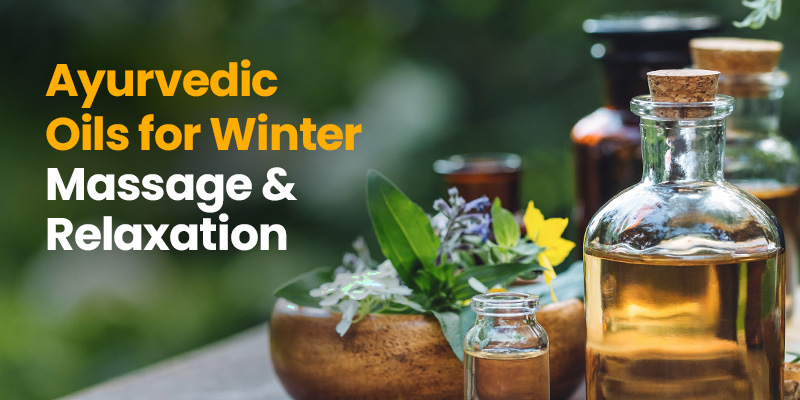Have you ever noticed how your skin feels drier and your muscles tighter during winter? The cold months tend to sap the moisture from our bodies and leave us yearning for warmth and comfort. What if there was a natural way to keep your body hydrated, your muscles relaxed, and your mind at peace, all while embracing the winter season?
Ayurvedic massage offers a simple yet effective solution to beat the winter blues. With nourishing oils and soothing techniques, this age-old practice is the perfect antidote to the chilly weather. Let’s explore how Ayurveda views winter massage, the best oils to use, and how you can maximise its benefits.
Importance of Winter Massage
Winter can be harsh on your body. The cold air often makes your skin dry and your joints stiff, leaving you feeling less active and more prone to aches and pains. A good winter massage not only helps keep your skin soft and hydrated but also improves blood circulation, ensuring that your muscles and joints stay supple.
Massage during winter isn’t just about physical comfort. It’s also a way to relax your mind, release stress, and restore balance. By taking the time to care for yourself, you can feel more energised and ready to take on the challenges of the colder months.
Ayurvedic Explanation of Massage in Winter
According to Ayurveda, winter is governed by the Kapha dosha, which is characterised by heaviness, coldness, and a slower pace. Massage, or Abhyanga, is considered essential during this season as it helps balance these qualities. Ayurvedic texts suggest that massaging the body with warm oils not only nourishes the skin but also generates internal heat, keeping the body warm and energised.
Massage is also believed to calm the Vata dosha, which can increase during winter due to the dry and windy conditions. The warming and grounding nature of Ayurvedic oils work wonders in keeping the body balanced, the skin moisturised, and the joints lubricated. It’s like wrapping yourself in a cosy blanket of wellness!
Best Ayurvedic Oils for Winter
Not all oils are created equal when it comes to winter massage. Here are some of the best Ayurvedic oils that offer warmth, nourishment, and relaxation during the colder months:
Sesame Oil
Known as the king of oils in Ayurveda, sesame oil is deeply nourishing and warming. It penetrates the skin effectively, providing hydration and improving blood circulation. Its grounding properties make it ideal for calming Vata dosha.
Almond Oil
Rich in vitamin E, almond oil is excellent for keeping the skin soft and radiant during winter. It also helps relieve muscle tension, making it perfect for a relaxing massage.
Ashwagandha Oil
This herbal oil is great for soothing stress and promoting relaxation. It’s also known for its ability to strengthen the body and keep joints flexible during the cold months.
Mustard Oil
Mustard oil has a natural warming effect and is perfect for improving blood circulation. It’s particularly effective for relieving joint pain and stiffness.
Eucalyptus Oil
Eucalyptus oil, often mixed with a carrier oil like sesame, is ideal for clearing nasal congestion while also offering a refreshing and relaxing massage experience.
Massage Techniques for Maximum Relaxation
To truly benefit from Ayurvedic massage, it’s important to use the right techniques. Here are some simple tips to ensure you get the most out of your winter massage session:
- Warm the Oil: Always warm the oil before applying it to your body. Warm oil penetrates the skin more effectively and provides a comforting sensation during the cold months.
- Start with the Feet and Head: These are considered key energy points in Ayurveda. Begin your massage by gently applying oil to your feet and scalp for maximum relaxation.
- Use Long Strokes and Circular Motions: For large muscles like the arms and legs, use long, sweeping strokes. For joints, apply the oil in gentle, circular motions.
- Apply Gentle Pressure: Use gentle but firm pressure to knead muscles, especially in areas where tension tends to build up, such as the shoulders and lower back.
- Take Your Time: Spend at least 15-20 minutes on the massage to allow the oil to nourish your skin and muscles deeply.
These techniques not only relax your body but also improve blood flow and detoxify the skin, leaving you refreshed and rejuvenated.
Creating a Winter Massage Ritual at Home
Transforming Ayurvedic massage into a regular ritual at home can make it even more enjoyable and effective. Here’s a simple routine you can follow to create a spa-like experience right in your own space:
- Set the Mood: Light some calming incense or scented candles to create a serene atmosphere. Soft music or natural sounds like flowing water can enhance relaxation.
- Warm the Oil: Gently heat your chosen Ayurvedic oil in a bowl of warm water. Ensure it’s comfortably warm but not too hot.
- Choose the Right Time: Morning is ideal for a massage as it helps energise your body for the day. If mornings are busy, evenings work well to unwind and release the day’s tension.
- Take a Warm Bath Afterward: Let the oil soak into your skin for about 30 minutes before rinsing it off with a warm shower or bath. This helps lock in moisture and leaves your skin feeling silky smooth.
Making this ritual a weekly or bi-weekly practice can help you feel more connected to your body, reduce stress, and truly enjoy the calming essence of winter.
Conclusion: Embrace Winter with Ayurvedic Massage
Winter doesn’t have to feel like a battle against the elements. With Ayurvedic massage and the right oils, you can transform the season into a time of warmth, relaxation, and self-care. Whether it’s the nourishing touch of sesame oil or the invigorating scent of eucalyptus, these natural remedies can help you stay balanced and healthy. So, why not treat yourself to the gift of Ayurvedic massage this winter? It’s a simple yet powerful way to keep both your body and mind in harmony during the colder months.





